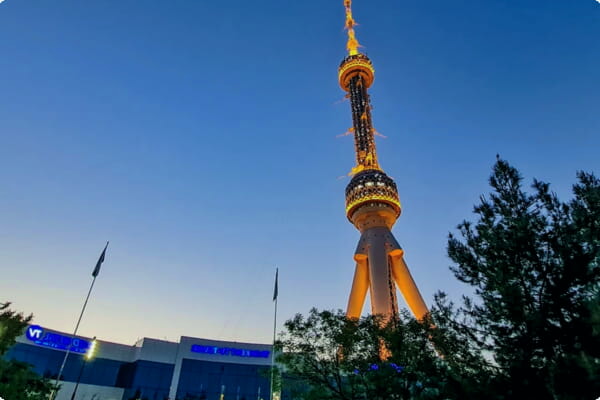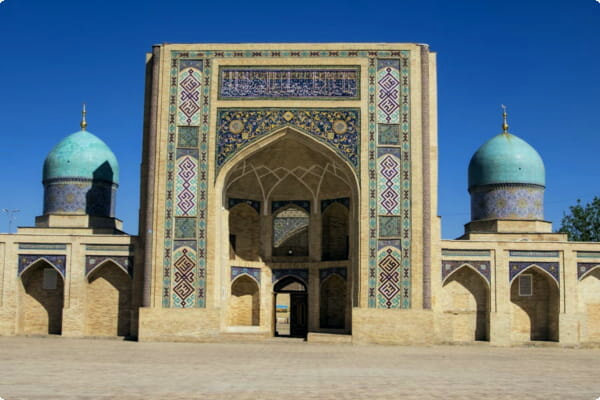Located in Central Asia, Uzbekistan is a former Soviet republic that has an abundance of sites, including mosques and mausoleums, that were linked to the Silk Road. These places are great places to visit and explore.
Tashkent
Known as the capital of Uzbekistan, Tashkent is home to over 2.5 million people. Most of the population is Uzbek, but there are many other nationalities living in the city. The city is home to many historical monuments and museums. These museums offer visitors a glimpse into the history of Uzbekistan.
One of the best things to do in Tashkent is visit the Khazrati Imam complex. This complex is one of the oldest in the country. It was built about four centuries ago. The complex includes several mosques and mausoleums, as well as Barak Khan Madrasah. The complex is located in the grounds of the Tashkent Islamic University.

Another must-see is the Tashkent National Ballet. This ballet is famous for its outstanding performances. This ballet performs at the Navoi Theatre.
Tashkent has many museums, which offer visitors a glimpse into the history of the city and its people. These museums include the State Museum of History of Uzbekistan. The museum houses centuries-old Buddhist artifacts.
One of the most beautiful things to do in Tashkent is to take a stroll through the Navoi Park. This park has several historical statues, as well as restaurants and food stalls. This is also where you can see the Monument of Uzbekistan.
Tashkent is also home to several modern landmarks, including the Istiqlol Palace. This is a beautiful building that combines medieval architecture with modern business centers.
Fergana Valley
Located in Central Asia, the Ferghana Valley is an interesting region. It is often considered the "cradle of ancient civilizations" and is surrounded by the Tien Shan and Pamir-Alai mountains. It has a rich agricultural soil, perfect for growing food. It is also home to many birds of prey.
It is one of the most important regions of Uzbekistan, and has been a political center for many centuries. It is also known for its crafts, and many of them are sold at bazaars.
The Valley is a good place for learning about the local culture. There are some ancient monuments and medieval cities in the area. The area has been occupied by many different empires. It was once a popular hiking destination, but has not been a tourist destination for some time.
Today, the region is home to eight million people, 90% of which are Uzbek. The Valley has a high unemployment rate compared to other parts of Central Asia.
Aside from its rich cultural heritage, Fergana Valley is also a major silk production center. It is home to several major irrigation canals. There are also silk "factories" in Margilan and Kosonsoy.
The region is home to several endangered animals. It is illegal to hunt these animals.
The region is home to many crafts, such as skullcaps, knives, skull caps, silk, and embroidery. Crafts are usually sold in bazaars, and at trade shows. They are made by master craftsmen using traditional methods.
Bukhara
Located in Uzbekistan, the ancient city of Bukhara is known for its centuries-old architecture and monuments. It was a thriving centre of Islamic theology, trade, and crafts during medieval times.
The Samanids Mausoleum is one of the oldest structures in Bukhara, built during the Islamic period. This mausoleum has a unique combination of Zoroastrian and Islamic elements, making it a fascinating attraction.
Another Bukhara attraction is the Po-i-Kalyan complex, one of the finest examples of Islamic architecture in the world. This complex includes a mosque and madrasah. It was constructed in the Turkic Karakhanid dynasty in 1127. It is 48 meters high, and is decorated with terracotta bricks.
Aside from its many historical sites, Bukhara is also a place of lively bazaars and caravanserais. In the past, merchants from China, India, and Venice came to Bukhara to buy hand-woven textiles.
Bukhara's bazar has a variety of souvenir shops. You can also find a great selection of ice cream and local delicacies here. The bazar is also home to an elevator. The building was originally a caravanserai, and was later converted into a madrassa in 1623.
Bukhara is also home to the summer palace of the kings of Bukhara. This palace provides insight into the court life of Bukhara in the period before the Soviets took control.
Bukhara is also home to an amusement park, Samonid Park. This park is located outside the city, so it is a good way to take a break from the hustle and bustle of the city.
Chimgan
Located in the Tian Shan mountain range, Uzbekistan's Chimgan is one of the most beautiful places in the country. It is a popular skiing destination, offering a wide range of winter sports activities. It is also popular for hiking, rock climbing, and water sports.
The Chimgan mountains are the part of the Chatkal range in the western Tian Shan. They have an average annual precipitation of 650 mm. This allows the development of ski tourism in Chimgan. Several chair lifts are available, and beginners can try free-ride skiing.
The region of the Chimgan Mountains is protected by the state, and the territory is included in Ugam-Chatkal National Park. The park features waterfalls and trails that tourists can follow.
The western ridge of Big Chimgan is at an altitude of more than 3000 meters. It has many memorial plaques, and it can be visited without special equipment. The grotto in the ridge has memorial plaques as well.
The region of the Chimgan mountains offers great opportunities for mountaineering, and you can hire guides for your excursions. You can also try horse riding, hang gliding, or sledges.
There are many restaurants and cafes where you can relax and have coffee. You can also go into town for shopping. The town of Chimgan has about 1,000 inhabitants. It is located 24 km from Uzbekistan's border. The village offers accommodation based on home-stay facilities. There are also community-based tourism accommodations.
Minaret of Kalta Minor
Located on the territory of Ichan-Kala in Uzbekistan, the Kalta Minor Minaret is a spectacular sight. The tower was built in the 19th century as a grandiose structure. It was intended to rival the city of Bukhara.
The structure was to be the tallest in Central Asia at the time. However, the construction never reached the intended height. The actual height of the Kalta Minor is only 26 meters.
The minaret was supposed to have a tapered shape with a wide base. The architects believed that the narrow shape would reduce the load and allow for a long-lasting structure. However, construction of the minaret stopped after Khan Abdullakhan's assassination in 1855.
The minaret was originally planned to be 110 meters tall. The master architect of the structure left the building when the plot was revealed.
The XIX century inscriptions on the tower were restored in 1996-1997. Rustam Tahirov, who is a master restorer of majolica art, restored letters that described the tall minaret. He also restored missing inscriptions in Arabic script in Farsi. The restoration was based on the anniversary of the city's 2500th anniversary.
The structure is now covered with majolica and glazed tile. The decoration is rich and bright. The tiles are in various shades of blue and green. They look like dancing lights when the sun strikes off the tiles. The tower is decorated with a variety of ornaments.
Zindan of Emir
Located behind the Ark Fortress of Bukhara, Zindan of Emir is a museum that focuses on the legal proceedings of the 19th and 20th century. The word "zindan" means "hole for prisoners confinement". Zindan was built as a prison in the 18th century and was used for this purpose until 1920. The museum is housed in one of the cells where prisoners were confined.
The top part of Zindan contains a tomb of the "saint" Kuchkar-Ata, an 8th-century prisoner. This area contains a narrow corridor for prisoners to walk in.
The interior of the mausoleum is very rich, with 20 mausoleums and breathtaking tile work. It is a magnificent example of Uzbek tile work and sets the mausoleum apart from other buildings in the region.
Inside the mausoleum, visitors can see dummy prisoners. These aren't very convincing. They are just a representation of what prisoners would look like. But it's an interesting experience to see how prisoners were treated.
Visitors can also walk through a narrow corridor in Zindan of Emir. The prisoners were usually criminals, usually sentenced to death.
The Ark of Bukhara was a residence of the Emir of Bukhara. In fact, it was the emir's prison. There were dungeons and slave quarters, a palace, and a mosque. The mosque was a place where the Emir's officials came to talk to the people of the district. People would discuss issues and elections for the district administration would be held here.




